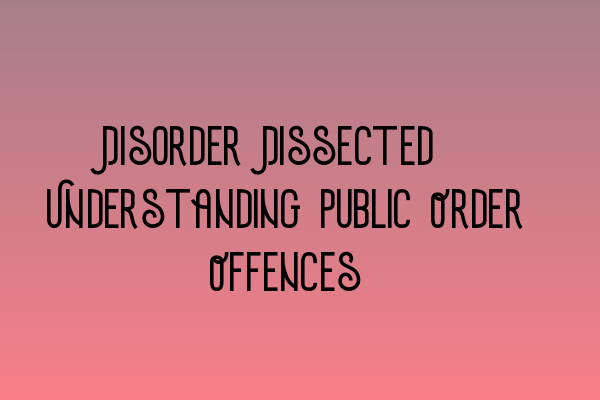Disorder Dissected: Understanding Public Order Offences
Welcome to the blog of SQE Criminal Law & Practice Law UK! In this article, we will delve deep into the realm of public order offences and provide you with a comprehensive understanding of this intriguing area of law.
What are Public Order Offences?
Public order offences refer to a range of criminal acts that cause disturbance or fear within the public domain. These offences are often committed in public places, such as streets, parks, or public transportation.
Public order offences include but are not limited to:
- Disorderly conduct
- Violent behavior
- Public intoxication
- Harassment or threatening behavior
- Rioting
- Incitement
It is crucial to have a thorough understanding of the various subcategories of public order offences in order to effectively navigate the complexities surrounding such cases. If you are preparing for your SQE 1 exams, make sure to check out our SQE 1 Practice Exam Questions and SQE 1 Practice Mocks FLK1 FLK2 to enhance your knowledge and test your understanding of criminal law.
Understanding the Legal Framework
Public order offences are governed by a set of legal provisions, which may vary depending on your jurisdiction. It is crucial to familiarize yourself with the applicable laws and regulations to effectively handle public order cases.
Being abreast of the latest legal developments and interpretations is vital for criminal law practitioners. To stay up-to-date, consider enrolling in our comprehensive SQE 2 Preparation Courses or our specialized SQE 1 Preparation Courses, which will equip you with the necessary knowledge and skills to excel in your legal career.
Punishments and Sentencing
Public order offences can carry severe penalties, ranging from fines to imprisonment. The severity of the punishment depends on the specific offence committed, its gravity, and any aggravating or mitigating circumstances.
The court takes several factors into account when determining the appropriate sentence, such as the offender’s criminal history, the impact of the offence on the community, and the level of harm caused. It is crucial for criminal law practitioners to possess a deep understanding of sentencing guidelines and precedents.
If you are interested in learning more about the sentencing aspect of criminal law, check out our insightful article on SRA SQE Exam Dates. It provides valuable information on the examination process and the topics covered in the SQE 1 and SQE 2 exams.
Conclusion
In summary, public order offences encompass a wide range of criminal acts that disrupt public order and wellbeing. As legal professionals, it is crucial to have a solid understanding of the legal framework and legislation surrounding these offences.
To enhance your knowledge and skills in criminal law, make sure to take advantage of our comprehensive SQE 1 and SQE 2 preparation resources, including the SQE 1 Practice Exam Questions and SQE 1 Practice Mocks FLK1 FLK2.
By staying up-to-date with the latest legal precedents, guidelines, and sentencing practices, you can effectively advocate for your clients and contribute to a more just society.
